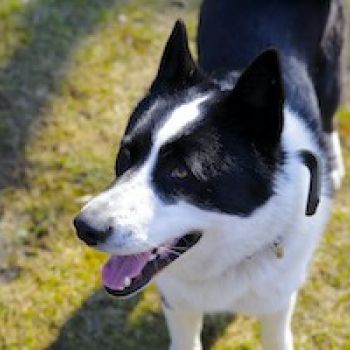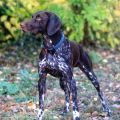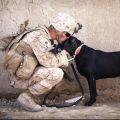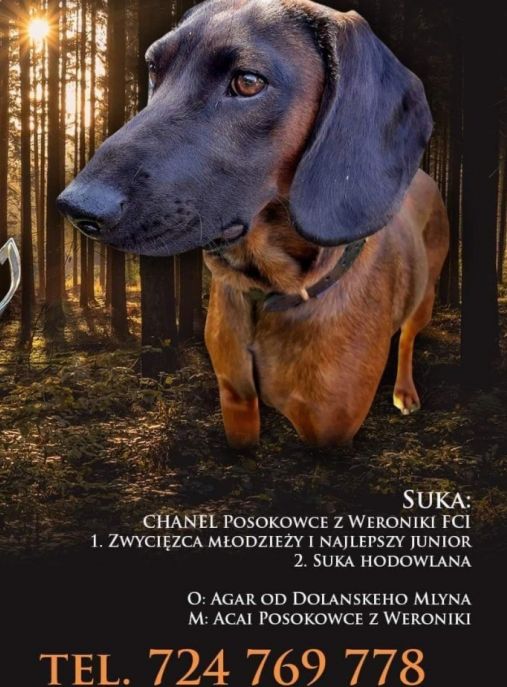The Russian-European Laika is a versatile and intelligent dog breed that has a rich history and a strong connection to its Russian roots. This breed is known for its exceptional hunting skills, endurance, and loyalty. With a well-balanced temperament and a striking appearance, the Russian-European Laika has gained popularity not only in its native Russia but also in other parts of the world.
The history of the Russian-European Laika dates back several centuries. These dogs were originally bred by indigenous people in the northern regions of Russia, particularly in the areas of Karelia, Arkhangelsk, and Komi. The Laika breed was developed to assist in various hunting tasks, including tracking and retrieving game, as well as guarding the home and family.
According to the FCI (Fédération Cynologique Internationale) typology, the Russian-European Laika belongs to Group 5, which includes Spitz and primitive types of dogs. Within this group, the breed is classified under Section 2 - Nordic Hunting Dogs. This classification highlights the breed's hunting abilities and its close relationship with the natural environment.
The Russian-European Laika is primarily a hunting dog, but it also excels in other roles such as a search and rescue dog, a sled dog, and a family companion. These dogs are highly adaptable and can thrive in various climates and terrains, making them suitable for different types of hunting, including tracking large game, treeing small game, and even hunting in water.
In terms of physical characteristics, the Russian-European Laika is a medium-sized dog with a well-muscled body and a strong build. The average weight of a male Laika ranges from 40 to 55 pounds (18 to 25 kilograms), while females typically weigh between 35 and 50 pounds (16 to 23 kilograms). The height at the withers for males is around 21 to 23 inches (53 to 58 centimeters), and for females, it is slightly smaller, ranging from 19 to 21 inches (48 to 53 centimeters).
The breed's coat is dense, double-layered, and weather-resistant, providing excellent protection in harsh climates. The outer coat is straight and coarse, while the undercoat is soft and thick. The color of the coat can vary, with common colors being black, white, gray, or a combination of these. The Laika's tail is usually curled over the back, adding to its distinctive appearance.
The Russian-European Laika has a life expectancy of around 12 to 15 years, which is relatively long compared to some other dog breeds. This breed is generally healthy and robust, but like any dog, it can be prone to certain health issues such as hip dysplasia, progressive retinal atrophy, and allergies. Regular veterinary check-ups, a balanced diet, and sufficient exercise are essential for maintaining the overall well-being of these dogs.
One interesting fact about the Russian-European Laika is its exceptional sense of smell. These dogs have a highly developed olfactory system, which enables them to track scents over long distances. This makes them excellent hunting companions, as they can locate game even in challenging terrains.
Another notable characteristic of the Russian-European Laika is its strong bond with its human family. These dogs are known for their loyalty, affection, and protective nature. They form deep connections with their owners and are highly trainable, making them suitable for various activities such as obedience training, agility, and even therapy work.
In conclusion, the Russian-European Laika is a remarkable dog breed with a fascinating history and exceptional hunting abilities. With its striking appearance, versatile skills, and loyal temperament, this breed has become a beloved companion for many families around the world. Whether as a hunting partner or a devoted family pet, the Russian-European Laika continues to leave a lasting impression with its unique qualities and unwavering devotion.
The Russian-European Laika dogs are a remarkable breed known for their unique character and exceptional qualities. These dogs possess a combination of intelligence, loyalty, and adaptability that make them excellent companions and working dogs. In this text, we will delve into the character of Russian-European Laika dogs, their behavior, and how to raise and train them effectively.
First and foremost, Russian-European Laikas are highly intelligent dogs. They possess a sharp mind and are quick learners. This intelligence allows them to excel in various activities, including hunting, search and rescue, and obedience training. However, it is important to note that their intelligence can sometimes lead to stubbornness, so consistent and patient training is necessary.
These dogs are known for their loyalty and devotion to their families. They form strong bonds with their owners and are always eager to please them. Russian-European Laikas are highly protective of their loved ones and will go to great lengths to ensure their safety. This loyalty makes them excellent guard dogs, as they are naturally suspicious of strangers and will alert their owners to any potential threats.
In terms of behavior, Russian-European Laikas are generally friendly and sociable. They get along well with children and other pets if properly socialized from a young age. However, they can be reserved and aloof with strangers, which is a characteristic deeply ingrained in their nature. Early socialization is crucial to ensure they grow up to be well-rounded and confident dogs.
When it comes to raising and training Russian-European Laikas, consistency and positive reinforcement are key. These dogs respond well to reward-based training methods, such as treats, praise, and play. Harsh or punitive training techniques should be avoided, as they can lead to fear or aggression in these sensitive dogs. It is important to establish yourself as a firm but fair leader, providing clear boundaries and consistent rules.
Exercise is essential for Russian-European Laikas, as they are an active and energetic breed. They require daily physical and mental stimulation to prevent boredom and destructive behavior. Long walks, jogging, and interactive play sessions are great ways to keep them engaged and satisfied. Additionally, providing them with puzzle toys or tasks that stimulate their problem-solving abilities can help channel their intelligence in a positive direction.
Russian-European Laikas are known for their independence, which can sometimes make training a challenge. They have a strong prey drive and may be prone to chasing small animals if not properly trained and supervised. Early socialization and obedience training are crucial to ensure they respond reliably to commands and can be trusted off-leash.
In conclusion, Russian-European Laika dogs possess a unique character that combines intelligence, loyalty, and adaptability. They are intelligent, loyal, and protective of their families. Proper socialization, consistent training, and regular exercise are essential for raising a well-behaved and happy Russian-European Laika. With the right approach, these dogs can thrive as loving companions and excel in various working roles.
The Russian-European Laika is a beautiful and intelligent breed of dog that requires proper care and attention to thrive. Here are some tips on how to care for these dogs, including what to do and what not to do:
1. Exercise: Russian-European Laikas are active and energetic dogs that require regular exercise to stay healthy and happy. Provide them with daily walks, playtime, and mental stimulation. Engaging in activities like agility training or hiking can be beneficial for their physical and mental well-being.
2. Grooming: This breed has a thick double coat that requires regular grooming. Brush their fur at least once a week to prevent matting and remove loose hair. During shedding seasons, daily brushing may be necessary. Bathing should be done only when necessary to avoid stripping the natural oils from their coat.
3. Nutrition: Provide a balanced and nutritious diet to ensure the overall health of your Russian-European Laika. Consult with a veterinarian to determine the appropriate portion sizes and choose high-quality dog food that meets their specific dietary needs. Avoid overfeeding, as this breed is prone to obesity.
4. Training and Socialization: Early socialization and obedience training are crucial for Russian-European Laikas. They are intelligent and independent dogs, so consistent and positive reinforcement-based training methods work best. Expose them to various environments, people, and other animals to help them develop good manners and prevent behavioral issues.
5. Mental Stimulation: These dogs have a strong prey drive and are highly intelligent. Provide them with mental stimulation through puzzle toys, interactive games, and training sessions. This will prevent boredom and destructive behavior.
6. Health Care: Regular veterinary check-ups are essential to monitor the overall health of your Russian-European Laika. Vaccinations, deworming, and flea/tick prevention should be kept up to date. Additionally, dental care is crucial, so brush their teeth regularly and provide dental chews or toys.
7. Safety: Ensure a safe environment for your Russian-European Laika by securing your yard with a sturdy fence. This breed has a strong hunting instinct, so they may chase small animals if given the opportunity. Keep them on a leash during walks to prevent them from running off.
8. Avoid Overexertion: While Russian-European Laikas are energetic, be cautious not to overexert them, especially during hot weather. They have a thick coat that can make them prone to overheating. Provide plenty of fresh water and shade during outdoor activities.
9. Avoid Harsh Training Methods: Russian-European Laikas respond best to positive reinforcement training techniques. Avoid using harsh punishments or physical force, as it can damage the trust and bond between you and your dog.
10. Mental and Physical Challenges: These dogs thrive when given tasks and challenges. Engage them in activities like scent work, obedience trials, or even participating in dog sports. This will keep them mentally stimulated and strengthen the bond between you and your dog.
Remember, every dog is unique, and individual care requirements may vary. It is essential to spend quality time with your Russian-European Laika, providing them with love, attention, and a stimulating environment to ensure they lead a happy and fulfilling life.
The Russian-European Laika dog breed is known for its striking and diverse coat colors, each possessing its own unique charm. However, one of the most common and iconic colors found in these dogs is a beautiful combination of white, black, and shades of gray. This coloration gives the Russian-European Laika an elegant and regal appearance that is instantly recognizable.
Starting with the base color, the majority of the Russian-European Laika's coat is predominantly white. This pristine white serves as a canvas upon which the other colors are artfully displayed. It symbolizes purity and innocence, adding a touch of grace to the overall appearance of the dog.
Intermingled with the white are patches of black and various shades of gray. These patches are not uniform but rather scattered across the dog's body in a seemingly random yet aesthetically pleasing pattern. The black patches are often found on the back, head, and ears, creating a striking contrast against the white background. These dark areas add depth and definition to the dog's features, enhancing its overall appearance.
The shades of gray found in the Russian-European Laika's coat range from light silver to dark charcoal. These gray patches are usually found on the sides, chest, and legs of the dog, creating a harmonious blend with the black and white. The varying shades of gray add dimension and texture to the coat, giving it a visually appealing and dynamic look.
The distribution of these colors can vary from dog to dog, making each Russian-European Laika unique in its appearance. Some dogs may have larger black patches, while others may have more extensive gray areas. This individuality adds to the breed's charm and allure, making them stand out in a crowd.
The coloration of the Russian-European Laika's coat not only contributes to its physical beauty but also serves a practical purpose. The white patches help the dog blend in with its snowy surroundings, making it an excellent companion for hunting and outdoor activities in colder climates. The black and gray patches provide camouflage in forested areas, allowing the dog to move stealthily and remain inconspicuous.
In conclusion, the common color of Russian-European Laika dogs is a captivating combination of white, black, and shades of gray. This coloration not only enhances the dog's physical appearance but also serves a practical purpose in its natural habitat. Whether in the snow or the forest, the Russian-European Laika's coat stands out as a testament to its beauty and adaptability.
The Russian-European Laika is a robust and hardy breed known for its excellent health. These dogs have evolved over centuries to adapt to the harsh climates and demanding working conditions of Russia. With proper care and attention, they can lead long and healthy lives.
One of the most common health issues seen in Russian-European Laikas is hip dysplasia. This hereditary condition affects the hip joints, causing pain, lameness, and difficulty in movement. Regular exercise and maintaining a healthy weight can help reduce the risk of hip dysplasia. Additionally, responsible breeders perform hip evaluations on their breeding stock to minimize the occurrence of this condition.
Another prevalent health concern in Russian-European Laikas is progressive retinal atrophy (PRA). PRA is a degenerative eye disease that leads to gradual vision loss and, in severe cases, blindness. Regular eye examinations by a veterinary ophthalmologist can help detect PRA early on, allowing for appropriate management and care.
Like many other dog breeds, Russian-European Laikas are also prone to certain skin conditions. Allergies, hot spots, and dermatitis can occur due to various factors such as food sensitivities, environmental allergens, or poor grooming practices. Regular bathing, proper nutrition, and avoiding potential allergens can help maintain healthy skin and coat.
Dental health is crucial for the overall well-being of Russian-European Laikas. Poor oral hygiene can lead to gum disease, tooth decay, and even systemic infections. Regular teeth brushing, dental check-ups, and providing appropriate chew toys can help keep their teeth clean and healthy.
Proper nutrition is vital for maintaining the health of Russian-European Laikas. A balanced diet that meets their nutritional needs is essential to support their active lifestyle. High-quality dog food, preferably formulated for medium to large breeds, should be provided in appropriate portions to prevent obesity and related health issues.
Regular exercise is crucial for the physical and mental well-being of Russian-European Laikas. These dogs are highly active and require ample opportunities to burn off energy. Daily walks, playtime, and engaging in activities such as agility or obedience training can help keep them fit and mentally stimulated.
Routine veterinary check-ups are essential to monitor the overall health of Russian-European Laikas. Vaccinations, parasite prevention, and early detection of any potential health issues are crucial for their well-being. Regular check-ups also allow for the timely administration of preventive measures such as heartworm medication and flea and tick control.
In conclusion, Russian-European Laikas are generally healthy dogs with a few common health concerns. Responsible breeding practices, regular veterinary care, proper nutrition, exercise, and attention to grooming and dental hygiene are key to ensuring their optimal health. With the right care and love, these dogs can enjoy a long and fulfilling life as loyal companions and working partners.
The Russian-European Laika is a medium-sized, active, and intelligent breed of dog that requires a well-balanced and nutritious diet to maintain optimal health and energy levels. Proper nutrition plays a crucial role in their overall well-being, ensuring they have the necessary nutrients to support their active lifestyle and maintain a healthy weight. Here is an extensive description of their nutrition, along with advice on feeding and what to avoid.
Protein is a vital component of a Laika's diet, as it helps in muscle development and repair. High-quality animal-based proteins such as chicken, turkey, beef, and fish should form the foundation of their diet. These proteins provide essential amino acids that are necessary for the proper functioning of their body. It is recommended to feed them lean cuts of meat, removing any excess fat or skin to prevent weight gain and potential health issues.
Carbohydrates are another important part of a Laika's diet, providing them with the necessary energy to fuel their active lifestyle. Opt for complex carbohydrates like whole grains (brown rice, oats, quinoa) and vegetables (sweet potatoes, carrots, broccoli). These sources of carbohydrates are rich in fiber, which aids in digestion and helps regulate blood sugar levels.
Fats are a concentrated source of energy and play a crucial role in a Laika's diet. However, it is important to choose healthy fats that provide essential fatty acids, such as omega-3 and omega-6. These fats support healthy skin and coat, promote brain function, and reduce inflammation. Good sources of healthy fats include fish oil, flaxseed oil, and coconut oil. It is important to note that fats should be provided in moderation to prevent excessive weight gain.
Feeding guidelines for a Russian-European Laika vary depending on their age, activity level, and overall health. Puppies require more frequent meals, typically three to four times a day, to support their rapid growth and development. As they mature, adult Laikas can be fed twice a day. However, highly active individuals may require additional meals or larger portions to meet their energy needs.
It is essential to monitor their weight and body condition regularly to ensure they are not becoming overweight or underweight. Adjust their portion sizes accordingly to maintain a healthy weight. Additionally, always provide fresh and clean water to keep them hydrated throughout the day.
While it is important to focus on providing a balanced diet, there are certain foods that should be avoided as they can be harmful to dogs. These include:
1. Chocolate: Contains theobromine, which is toxic to dogs and can cause various health issues.
2. Grapes and raisins: Can lead to kidney failure in dogs.
3. Onions and garlic: Can cause damage to a dog's red blood cells.
4. Avocado: Contains persin, which can be toxic to dogs.
5. Alcohol and caffeine: Both are highly toxic and can cause severe health problems.
Additionally, it is important to avoid feeding your Laika table scraps or excessive treats, as this can lead to weight gain and nutritional imbalances. Stick to a consistent and balanced diet specifically formulated for dogs.
In conclusion, providing a well-balanced and nutritious diet is essential for the health and well-being of Russian-European Laika dogs. Focus on high-quality proteins, complex carbohydrates, and healthy fats, while avoiding harmful foods. Regularly monitor their weight and adjust portion sizes accordingly. By following these guidelines, you can ensure your Laika remains healthy, active, and happy for years to come.






